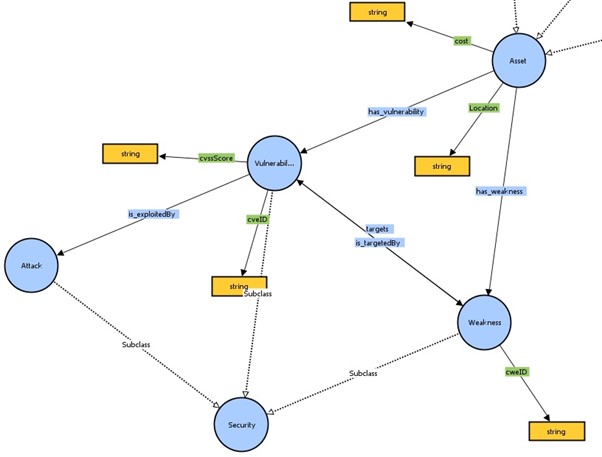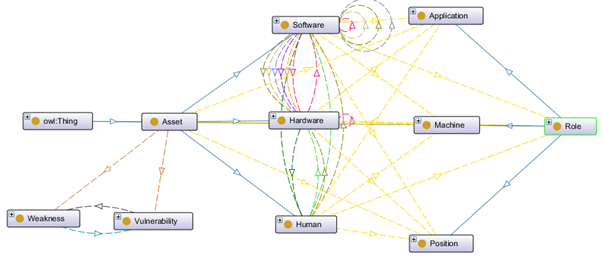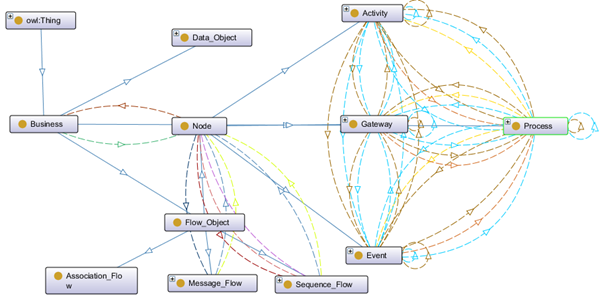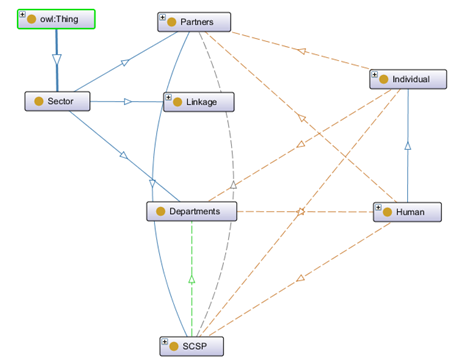This website uses cookies so that we can provide you with the best user experience possible. Cookie information is stored in your browser and performs functions such as recognising you when you return to our website and helping our team to understand which sections of the website you find most interesting and useful.
Semantic modelling using ontologies

Are you familiar with the power of semantic modelling using ontologies?
We use Ontologies in the CYRENE project to model assets and their dependencies in the field of the supply chain. Ontology modelling is an effective way to represent data in a structured way. Thanks to semantic web technology, models developed by ontology are both human and machine-readable. Moreover, the use of ontology modelling facilitates interoperability, integrity, and consistency checks within our modelling environments. The ontology-based modelling also incorporates reasoning capabilities as well as graph-based analysis. As a result, models that benefit from all these features are more robust and less likely to be affected by human error.
OntoCyrene is an ontology designed and implemented for modelling assets and their dependencies in the CYRENE project. This ontology provides three perspectives of the project, including:
- asset-driven,
- business-driven and
- sector-driven views.
For asset-driven view, OntoCyrene models human, software and hardware involved in the project. In doing so, a taxonomy was designed to associate related sub-categories to the ontology. Moreover, a variety of roles that humans, software and hardware may take in the project were provided in CYRENE. In addition to the above-mentioned facets, object properties which include relationships among these objects were defined and added to the OntoCyrene. Figure 1 shows a screenshot of the asset-driven view designed for the Cyrene project.

From a business-driven perspective, Business Process Model and Notation (BPMN) was used inside OntoCyrene as the basis for modelling business processes. As a result, OntoCyrene is able to capture dynamic aspects of the business processes by considering flow, connecting and data objects in the Cyrene project. Figure 2 shows the high abstract model of the business perspective in OntoCyrene

The last view provided by OntoCyrene is the sector-driven view. OntoCyrene models sector-specific facets of the Cyrene project. This includes modelling of the partners, linkage (both internal and external), and departments of the Supply Chain Service Provider (SCSP). Figure 3 depicts a high abstract sector-driven view of the OntoCyrene.
These three perspectives were joined to each other using a number of connecting points. Therefore, OntoCyrene represents related objects from all perspectives simultaneously. This provides an in-depth insight into the asset and its dependencies.

OntoCyrene was populated using a real-world in the field of vehicle transport supply chain to be validated by an Supply Chain Service Provider. Furthermore, the ontology was validated and verified using both quantitative and qualitative methods by applying OntoQA metrics and implementing a number of competency questions.
So what do you think? Reach out to us and share your views either by using our contact form or by following our social media accounts in Twitter and LinkedIn.
Don’t forget to subscribe to our Newsletter for regular updates!
This blog is signed by: Dr. Mohammad Heydari, Cyber Security Researcher, in Stockholm University
KEY FACTS
Project Coordinator: Sofoklis Efremidis
Institution: Maggioli SPA
Email: info{at}cyrene.eu
Start: 1-10-2020
Duration: 36 months
Participating organisations: 14
Number of countries: 10
FUNDING
 This project has received funding from the European Union’s Horizon 2020 Research and Innovation program under grant agreement No 952690. The website reflects only the view of the author(s) and the Commission is not responsible for any use that may be made of the information it contains.
This project has received funding from the European Union’s Horizon 2020 Research and Innovation program under grant agreement No 952690. The website reflects only the view of the author(s) and the Commission is not responsible for any use that may be made of the information it contains.

